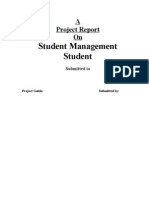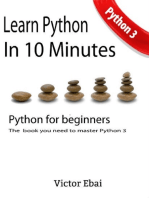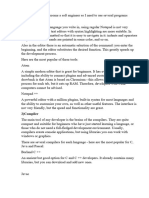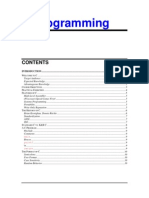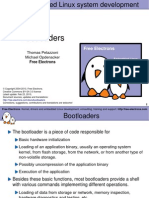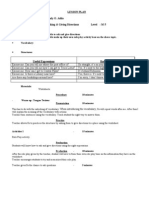0 ratings0% found this document useful (0 votes)
53 views1 Gnustep Frequently Asked Questions With Answers: 1.1 Compatibility
1 Gnustep Frequently Asked Questions With Answers: 1.1 Compatibility
Uploaded by
melvin45'Ni2gmodel' converts nib files from any system to a gmodel format file. 'Gnustep Renaissance' allows you to describe your user interfaces (that is, the windows in your program)
Copyright:
Attribution Non-Commercial (BY-NC)
Available Formats
Download as PDF, TXT or read online from Scribd
1 Gnustep Frequently Asked Questions With Answers: 1.1 Compatibility
1 Gnustep Frequently Asked Questions With Answers: 1.1 Compatibility
Uploaded by
melvin450 ratings0% found this document useful (0 votes)
53 views8 pages'Ni2gmodel' converts nib files from any system to a gmodel format file. 'Gnustep Renaissance' allows you to describe your user interfaces (that is, the windows in your program)
Original Title
Faq
Copyright
© Attribution Non-Commercial (BY-NC)
Available Formats
PDF, TXT or read online from Scribd
Share this document
Did you find this document useful?
Is this content inappropriate?
'Ni2gmodel' converts nib files from any system to a gmodel format file. 'Gnustep Renaissance' allows you to describe your user interfaces (that is, the windows in your program)
Copyright:
Attribution Non-Commercial (BY-NC)
Available Formats
Download as PDF, TXT or read online from Scribd
Download as pdf or txt
0 ratings0% found this document useful (0 votes)
53 views8 pages1 Gnustep Frequently Asked Questions With Answers: 1.1 Compatibility
1 Gnustep Frequently Asked Questions With Answers: 1.1 Compatibility
Uploaded by
melvin45'Ni2gmodel' converts nib files from any system to a gmodel format file. 'Gnustep Renaissance' allows you to describe your user interfaces (that is, the windows in your program)
Copyright:
Attribution Non-Commercial (BY-NC)
Available Formats
Download as PDF, TXT or read online from Scribd
Download as pdf or txt
You are on page 1of 8
1 GNUstep Frequently Asked Questions with
Answers
Last updated 1 January 2008. Please send corrections to gnustep-maintainer@gnu.org.
Also look at the user FAQ for more user oriented questions.
1.1 Compatibility
1.1.1 Is it easy to port OPENSTEP programs to GNUstep?
It is probably easy for simple programs. There are some portability tools to make
this easier, or rewrite the Makefiles yourself. You will also have to translate the NIB
files (if there are any) to GNUstep model files using the nib2gmodel program (from
ftp://ftp.gnustep.org/pub/gnustep/dev-apps).
1.1.2 How about porting between Cocoa and GNUstep?
It’s easier from GNUstep to Cocoa than Cocoa to GNUstep. Cocoa is constantly changing,
much faster than GNUstep could hope to keep up. They have added extensions and new
classes that aren’t available in GNUstep yet. Plus there are some other issues. If you start
with Cocoa:
• Use #ifndef GNUSTEP for Apple only code.
• Do not use CoreFoundation
• Do not use Objective-C++ (except with gcc 4.1 or later)
• Do not use Quicktime or other proprietary extension
• GNUstep should be able to read Cocoa nib files automatically, so there is no need to
port these, although you might want to have GNUstep specific versions of them anyway.
See also http://mediawiki.gnustep.org/index.php/Writing_portable_code for
more information.
1.1.3 Tools for porting
While the programming interface should be almost transparent between systems (expect
for the unimplemented parts, of course), there are a variety of other files and tools that are
necessary for porting programs.
‘ni2gmodel’
This program coverts nib files from any system, such as OPENSTEP to a
gmodel format file. Gmodel can be read directly by GNUstep or you can con-
vert this to a more GNUstep-native gorm format (using the Gorm interface
modeller). Note this is not necessary for Cocoa nibs - GNUstep can read these
directly.
‘Renaissance’
GNUstep Renaissance allows you to describe your user interfaces (that is, the
windows in your application, and the buttons, boxes, textfields, etc in the
windows) in simple and intuitive XML files, using an open, standard format
describing the logic of the interface. It has a number of advantages over the
proprietary nib format: portability, open standard, easy localization, theme-
ability, and intelligent autolayout.
‘Gorm’ The equivalent of the Interface Builder in GNUstep. It might be easier to just
recreate the interface using Gorm rather than dealing with translations.
‘OpenStep2GNUConverter and nfmake’
Two programs that allow you to convert PB files to GNUstep makefiles or
compile a program on GNUstep directly from PB files. They probably work
only for OPENSTEP systems and are a little out-of-date.
‘StepTalk’
A portable scripting environment that lets your do scripting in almost any
language you like.
1.1.4 Can I transfer archived data from GNUstep to Cocoa?
Apple’s archiving format is proprietary and not documented, so this poses a problem for
anyone wanting to implement compatibility with it. However, even if we reverse engineered
the format, there are enough differences between the class and ivar layouts to make this
sort of compatibility difficult. Not to mention the fact that we would constantly have to
keep up with the changes Apple made.
The new keyed archiving using XML file formats is much more portable, and GNUstep
is trying to maintain compatibility with Apple with this type of archiving.
1.1.5 Does distributed objects work between GNUstep and
Cocoa?
See the answer to the previous question (on archive compatibility) for why this won’t work
either.
1.1.6 Is there an Interface Builder for GNUstep?
There is an Interface Builder for GNUstep called Gorm. A lot of work has been put into
it and it works very well. You can download it from the ftp site or via http. The Project
Manager ProjectCenter is also available.
1.1.7 Can I use my original NIB files?
No - NeXT/Apple never documented their nib format, so GNUstep supports both the
’gmodel’ format (which stores information as text (property-lists) and can therefore be
edited ’by hand’) and binary archive format (which can be edited by Gorm). There IS a
conversion tool called nib2gmodel that can be compiled under OPENSTEP to convert nib
files to GNUstep gmodel files.
Newer nib files use XML format keyed archiving and may possibly be transportable,
although differences in class and ivar layout may still make this difficult.
1.1.8 Can one use the hybrid "Objective-C++"
No. at present the GNU compiler (gcc) does not support "Objective-C++". Soon to br
released gcc 4.1 will have this support, but it is still unclear how robust it will be.
1.1.9 Is there a plan to support the Java/YellowBox Bindings?
Yes. The GNustep Java library/bridge called JIGS is available now. JIGS is a free (LGPL)
Java Interface for GNUstep; it can automatically wrap Objective-C libraries based on
GNUstep, making them accessible directly to the Java programmer as if they were Java
libraries. As a side effect, it is also possible to use the whole engine in the reverse way:
JIGS provides a high level API to allow Objective-C programmers to start java virtual ma-
chines inside GNUstep Objective-C code and access java objects in the java virtual machine
transparently, as if they were objective-C objects.
1.1.10 What if I compile GNUstep under OPENSTEP/MacOS X?
GNUstep uses the X-windows display postscript extension. The interface to that is not the
same as the interface to the OPENSTEP/MacOS-X windows server. While someone could
write a backend library to provide the interface, nobody has bothered to date.
You can, however, use a GNUstep program with an X11 server running on MacOSX.
1.1.11 Is the Objective C API for GTK related?
No. GNUstep applications provide their GUI via the OpenStep API, which provides fully
object-oriented access to GUI manipulation.
The object-oriented nature of the libraries and language make it much easier for new
users to create their own subclasses rather than simply using the supplied widgets as in
other frameworks.
1.1.12 How about implementing parts of the Application Kit with
GTK?
Yes and No - The GNUstep architecture provides a single, platform-independent, API
for handling all aspects of GUI interaction (implemented in the gstep-gui library), with a
backend architecture that permits you to have different display models (display postscript,
X-windows, win32, berlin ...) while letting you use the same code for printing as for dis-
playing. Use of GTK in the frontend gui library would remove some of those advantages
without adding any.
That being said, a backend library could be implemented using gtk if anyone wanted
to do so. Since the frontend library handles most of the work involved in implementing
the OpenStep API, the backend is a relatively thin layer and the advantages of GTK over
direct xlib or win32 calls is likely to be minimal. If/when GTK is ported to more systems,
a backend written using it could be a valuable asset - volunteers are, as always, welcome.
1.2 Compiling and Developing
1.2.1 How can I get started programming?
Good question. Read the tutorials at the GNUstep web site. Also look at Apple’s docu-
mentation (pointers in the Resources section on the GNUstep web site.)
1.2.2 How can I help with GNUstep?
1. Write/debug library code
2. Write documentation
3. Update the task list and library headers
4. Write applications
Let people know what you are doing. Break your project up into the smallest units
you can. Feed back frequent updates to the maintainers. Ask questions in the discussion
mailing list.
Do remember that any changes beyond a few lines of code (or documentation) require
a disclaimer or copyright assignment to the Free Software Foundation before they can be
incorporated into the project. Get in touch with the GNUstep maintainer about this.
Don’t start with large-scale reorganization of anything - instead, get a general idea in
mind of what you want to do, and proceed as much as possible with incremental changes
that don’t break anything - that way you can make those incremental changes available to
the rest of the community at frequent intervals.
Don’t be afraid to give up - there is no shame in finding out that you have take on too
large/complex a project. It’s much better to ’resign’ and take on a smaller job than to just
stop without telling anyone.
Please document the code you add or change (using autogsdoc comments that begin
with a slash and two asterices). But PLEASE, do not copy from the Apple documentation
or any other copyrighted documentation.
1.2.3 Helping develop GNUstep
There is plenty of unimplemented stuff in the gui library and backend libraries that volun-
teers can work on - just browse through the code and see if it conforms to the documentation.
Specific tasks are noted in the developers section on the GNUstep website.
Once you have coded something, you could always write a testcase and documentation
for it :-)
1.2.4 Helping document GNUstep
All class documentation is written directly in the source code itself and translated using the
autogsdoc program. See the source code and documentation for autogsdoc for information
on documenting the classes.
Newcomers could write documentation for individual classes by comparing the Open-
Step specification, the MacOS-X documentation, and the GNUstep source. Documentation
should clearly note where individual methods are specific to OpenStep, MacOS-X or are
GNustep extensions.
More experienced people could write documentation on general programming topics, and
tutorials for new users.
Anyone willing to write documentation, either tutorials for using GNUstep, or reference
documentation for individual classes, should either write it in gsdoc or as plain ascii text
for someone else to format into gsdoc.
GNUstep documentation should have copyright assigned to the Free Software Founda-
tion.
1.2.5 How do I assign my contribution?
Everyone who contributes more than 20 lines of code or so needs to sign a copyright
assignment so that the FSF can have legal control of the copyright. This makes
it easier to defend against any copyright infringement suits. Contact the GNUstep
maintainer for instructions on how to do this or download and fill out the form
http://www.gnustep.org/resources/request-assign.future (instructions are
included).
1.2.6 How do I update the task list?
The task list (http://savannah.gnu.org/pm/?group_id=99) is supposed to tell people
what jobs are waiting to be done. Feel free to add to it or update the tasks that are there
(you need to create a login for yourself first).
One job of major importance that pretty much anyone can do is to look for jobs to add
to the task list. In the case of methods from the OpenStep specification or the MacOS-X
documentation not being present in the GNUstep libraries, it is also helpful to add the
method prototypes to the library header files.
Send any changes or additions to bug-gnustep@gnu.org.
A beginner can look through the MacOS-X documentation, the OpenStep specification
and the GNUstep source and contribute task items.
If a class or method is in MacOS-X and OpenStep but is not in GNUstep - it’s a high
priority TODO and should at least be added to the GNUstep headers and a dummy version
added to the source with a FIXME comment.
If a class or method is in MacOS-X but not OpenStep or GNUstep - it’s a low priority
TODO. It should be added to the GNUstep headers bracketed in #ifndef STRICT_OPENSTEP
If a class or method is in OpenStep but not in MacOS-X or GNUstep - it’s a low priority
TODO. It should be added to the GNUstep headers bracketed in #ifndef STRICT_MACOS_X
There are a couple of people working on this already, so it’s a good idea to get in touch
with Adam or Richard to coordinate efforts.
1.2.7 How do I start writing tests?
You can write testcases - where the libraries fail tests, you could either fix the problem, or
add it to the task list.
To write testcases, you need to use svn to install the latest GNUstep sourcecode you can
find. Then checkout the ’gnustep/tools/testsuite’ module from svn.
1.2.8 How do I start writing applications?
You can either look at the links on the GNUstep website for applications that have been
started, and email their owners to volunteer to help, or you can start your own project.
1.2.9 How can I help with the GNUstep website?
Talk to Adam Fedor fedor@gnu.org, the maintainer.
The GNUstep website is kept as a CVS module, but the largest portions of it (the
FAQ and the Documentation) are actually generated from files in the individual GNUstep
packages. Many highly changeable portions are kept on the Wiki, so anyone can change
these (first you need to get write access, though).
If you want to update the FAQ or documentation - grab the latest snapshot of the
GNUstep core you can find, update it from the svn repository, and work with the contents
of the appropriate documentation directory.
If you want to work on other parts of the website, you can grab a copy of the website
via anonymous CVS. See http://savannah.gnu.org/cvs/?group_id=99 for instructions
on how to do that.
The main task with the website is to figure out which bits are out-of-date (or wrong)
and update/mark-as-outdated as required.
1.2.10 Why doesn’t GDB support Objective-C?
Um, it does. As of GDB 6.0, gdb supports debugging of Objective-C code.
1.3 GNU Objective C Compiler and Runtime
1.3.1 What is the Objective C Runtime?
The Objective C Runtime Library provides C functions and data structures required to
execute an Objective C program.
The GNU Objective C Runtime Library offers everything NeXT’s runtime does, includ-
ing Categories, Protocols, ‘+poseAs:’, thread-safety, class initialization on demand, delayed
loading of classes, and initialization of static instances (such as @""-style string objects).
It also has several differences over NeXT’s implementation:
• GNU’s runtime provides “selector-types” along with each selector; NeXT’s does not.
A selector-type is a string that describes the C variable types for the method’s return
and argument values. Among other uses, selector-types is extremely helpful for fast
distributed objects implementations, (see GNUstep Base Library Section, below).
• Many of the GNU functions have different names than their corresponding NeXT func-
tions; the GNU names conform to the GNU coding standards. The GNUstep base
library contains a compatibility header that works with both runtimes. You should use
functions there or use OpenStep Foundation methods/functions instead of the basic
runtime functions so that you code can run with either system.
Apple has recently added new functionality to their runtime, including built-in excep-
tion handling, etc. Hopefully these will be ported to the GNU runtime in the future.
1.4 GNUstep Base Library
1.4.1 What is the GNUstep Base Library?
The GNUstep Base Library is a library of general-purpose, non-graphical Objective C ob-
jects. For example, it includes classes for strings, object collections, byte streams, typed
coders, invocations, notifications, notification dispatchers, moments in time, network ports,
remote object messaging support (distributed objects), event loops, and random number
generators.
It provides functionality that aims to implement the non-graphical portion of the Open-
Step standard (the Foundation library).
1.4.2 What is its current state of development?
GNUstep base is currently stable and, to the best of our knowledge, implements all of
the OpenStep functionality (except for a few classes that we feel are not useful). It also
implements most all of the new Cocoa classes. However we do some things, like scripting,
differently, so we don’t implement all the Cocoa classes.
1.4.3 What are the features of GNU Distributed Objects?
GNU Distributed Objects has many of the features of other distributed objects implementa-
tions, but, since it is free software, it can be ported to platforms for which other distributed
objects implementations are not available.
[ NOTE: The GNU distributed object facilities have the same ease-of-use as Apple’s; be
warned, however, that they are not compatible with each other. They have different class
hierarchies, different instance variables, different method names, different implementation
strategies and different network message formats. You cannot communicate with a Apple
NSConnection using a GNU NSConnection.
Here are some differences between GNU distributed objects and Apple’s distributed
objects: Apple NSDistantObject asks it’s remote target for the method encoding types and
caches the results; GNU NSDistantObject gets the types directly from the local GNU "typed
selector" mechanism if the information is known locally and only queries the remote target
or caching encoding types when using a method that is not known to the local process. The
NSProxy for the remote root object always has name and, once set, you cannot change the
root object of a NSConnection; the GNU Proxy for the remote root object has a target
address value just like all other Proxy’s, and you can change the root object as many times
as you like. ].
1.5 GNUstep GUI Library
1.5.1 What is the GUI Library?
The GNUstep GUI Library is a library of objects useful for writing graphical applications.
For example, it includes classes for drawing and manipulating graphics objects on the
screen: windows, menus, buttons, sliders, text fields, and events. There are also many
peripheral classes that offer operating-system-independent interfaces to images, cursors,
colors, fonts, pasteboards, printing. There are also workspace support classes such as data
links, open/save panels, context-dependent help, spell checking.
It provides functionality that aims to implement the ‘AppKit’ portion of the OpenStep
standard. However the implementation has been written to take advantage of GNUstep
enhancements wherever possible.
1.5.2 Explain the organization of the front- and back-ends
The GNUstep GUI Library is divided into a front- and back-end. The front-end contains
the majority of implementation, but leaves out the low-level drawing and event code. A
back-end can override whatever methods necessary in order to implement low-level drawing
event receiving. Different back-ends will make GNUstep available on various platforms. The
default GNU back-end will run on top of X Windows. Other back-ends could allow GNUstep
to run on OpenGL and WIN32 graphics/event platforms. Much work will be saved by this
clean separation between front- and back-end, because it allows different platforms to share
the large amount of front-end code.
1.5.3 What is the current state of development of the front-end?
Many of the classes are well implemented, if not thoroughly tested. See the GNUstep web
sites and read status information contained in the distribution for the most up-to-date
information.
1.5.4 What is the current state of development of the back-ends?
There are several backends currently available:
‘xlib’ This backend runs on X11 and uses standard xlib calls for implementing draw-
ing. It works well, but is limited in many areas due to the limitations of xlib
drawing.
‘art’ This is a very good backend that draws using the libart package and freetype
with near PostScript quality and functionality. It is currently the standard
backend (as long as the required libraries are installed).
‘w32’ This backend works on Windows and uses basic Windows drawing
‘cairo’ An up-and-coming backend. It still relies on unpublished functions in the cairo
library so using it is not for the beginner.
1.6 GNUstep DisplayGhostScript Server
1.6.1 What is the Display Ghostscript Server?
It is a free implementation of a Display PostScript server based on the GNU Ghostscript
program developed by Aladdin Enterprises and now owned by artofcode LLC.
At one point, GNUstep was using this for display purposes. However the development
of DGS has stopped as it is too difficult to maintain and no one wanted to work on it. Now
we are using other means of drawing.
1.6.2 What is its current state of development?
GNU contracted with Aladdin Enterprises to add some key features to GNU Ghostscript so
it could be used as a DPS server. This work has mostly been done, although Aladdin did
not completely finish the work that they were contracted for. (Because the work took longer
than specified and was not completed, Aladdin agreed to waive approximately $10,000 in
promised fees for the work that was actually done and delivered.) DGS works fairly well
with a single context. Alpha channel and compositing doesn’t work.
1.6.3 What is the relationship between the Display Ghostscript
Server and X Windows?
Display Ghostscript runs on top of X Windows.
You might also like
- History of The American Cinema Vol 01 Charles Musser - The Emergence of Cinema The American Screen To 1907Document551 pagesHistory of The American Cinema Vol 01 Charles Musser - The Emergence of Cinema The American Screen To 1907Marcelo Ikeda89% (9)
- User Manual A4.v.0.5.2 PDFDocument417 pagesUser Manual A4.v.0.5.2 PDFZe CabraNo ratings yet
- Student Management SystemDocument73 pagesStudent Management SystemManoj Kumar Jawlia75% (4)
- Supporting Linux Without An MMU Class #407: D. Jeff DionneDocument3 pagesSupporting Linux Without An MMU Class #407: D. Jeff Dionnemelvin45No ratings yet
- Aphrodite CleopatraDocument42 pagesAphrodite CleopatrajtgjorgeNo ratings yet
- Abaqus Manual Concrete ExamplesDocument2 pagesAbaqus Manual Concrete ExamplesMohamad Reza0% (1)
- Recording in The Congo by Alan P MerriamDocument6 pagesRecording in The Congo by Alan P Merriamberimbau8No ratings yet
- Cbbrowne Computing: Home Linux Info Books Free StuffDocument10 pagesCbbrowne Computing: Home Linux Info Books Free StuffSwapna KanseNo ratings yet
- Python InfoDocument5 pagesPython InfoswelllNo ratings yet
- Go Lang: Why You Should Learn Go?Document2 pagesGo Lang: Why You Should Learn Go?Rahul SinghNo ratings yet
- The Go Handbook - DevTwitterDocument44 pagesThe Go Handbook - DevTwittererfan ShasaldiniNo ratings yet
- Go HandbookDocument44 pagesGo Handbookguillermo ocegueda0% (1)
- CHPTR 1 PascalDocument14 pagesCHPTR 1 PascalKhalid ElassaadNo ratings yet
- Oslo College C Programming Tutorial (And GCC Guide)Document300 pagesOslo College C Programming Tutorial (And GCC Guide)Navid HallajianNo ratings yet
- Introduction To GolangDocument7 pagesIntroduction To Golangmamta yadavNo ratings yet
- LibFredo6 User Manual - English - V3.4 - 14 Sep 09Document5 pagesLibFredo6 User Manual - English - V3.4 - 14 Sep 09Oskars ElksnisNo ratings yet
- Contributing To Open Source ProjectsDocument8 pagesContributing To Open Source ProjectsZachary LloydNo ratings yet
- LinuxDocument13 pagesLinuxAleksandros HodoNo ratings yet
- Object Oriented Programming Using C++: ETCS-258Document27 pagesObject Oriented Programming Using C++: ETCS-258nin culusNo ratings yet
- Townx: An Introduction (Of Sorts) To Javascript Desktop Application Development With Gjs and ClutterDocument9 pagesTownx: An Introduction (Of Sorts) To Javascript Desktop Application Development With Gjs and ClutterGerardo GonzalezNo ratings yet
- DEV-C++ and OPENGL (For MS Windows 98/NT/2000/XP) : InstallationDocument4 pagesDEV-C++ and OPENGL (For MS Windows 98/NT/2000/XP) : Installationnieucom_3000No ratings yet
- Two Scoops of Django 3x - Compress 2Document50 pagesTwo Scoops of Django 3x - Compress 2Can İsildarNo ratings yet
- Project 3Document13 pagesProject 3api-257819714No ratings yet
- Talking Org ModeDocument6 pagesTalking Org ModesweelinckNo ratings yet
- CtutDocument262 pagesCtutgidramorzuNo ratings yet
- Getting Started With Phonegap: Phonegap and Apache CordovaDocument18 pagesGetting Started With Phonegap: Phonegap and Apache CordovaMario Gutiérrez HernándezNo ratings yet
- Hello 4Document1 pageHello 4d4t4d5en53No ratings yet
- Tutorial NodeJS Segunda ParteDocument5 pagesTutorial NodeJS Segunda ParteHelton Desenvolvimento PascalNo ratings yet
- Programming: G L: T N G LDocument9 pagesProgramming: G L: T N G LNikunj VadodariaNo ratings yet
- Python Notes Unit1Document62 pagesPython Notes Unit1hanumanNo ratings yet
- The Freeglut Project - AboutDocument2 pagesThe Freeglut Project - Aboutciuciu.denis.2023No ratings yet
- Console Mode Pascal - Free Pascal WikiDocument7 pagesConsole Mode Pascal - Free Pascal WikideviNo ratings yet
- How To Write Shared LibrariesDocument0 pagesHow To Write Shared Librariesscribdbook1234No ratings yet
- Igual-Seguà 2017 Chapter ToolboxesForDataScientistsDocument24 pagesIgual-Seguà 2017 Chapter ToolboxesForDataScientistsBacem ChNo ratings yet
- ManualDocument97 pagesManualdege88No ratings yet
- LXMLS Guide 2020Document105 pagesLXMLS Guide 2020Iliana VargasNo ratings yet
- DocumengitDocument9 pagesDocumengitgekenopNo ratings yet
- Python Notes Unit1Document62 pagesPython Notes Unit1ert345615No ratings yet
- 232 Lab, Lab 01: Part 1: First LoginDocument10 pages232 Lab, Lab 01: Part 1: First LoginJoel CurtisNo ratings yet
- SSE-256 Python NotesDocument166 pagesSSE-256 Python Notesruthviksaikudupudi760No ratings yet
- Discovering AmsterdamDocument632 pagesDiscovering AmsterdamivesomthingtosayNo ratings yet
- Python and DjangoDocument25 pagesPython and DjangoMOHIT GUSAIN100% (2)
- Julia TutorialDocument53 pagesJulia Tutorialsolrac1308No ratings yet
- Wave OSDR0 Developer ManualDocument632 pagesWave OSDR0 Developer ManualOned GómezNo ratings yet
- Neptune Getting Started GuideDocument73 pagesNeptune Getting Started GuideJuan Carlos FloresNo ratings yet
- Mono DotGNUDocument4 pagesMono DotGNUMohan Ram SNo ratings yet
- Deno HandbookDocument46 pagesDeno Handbookluis_gparroyoNo ratings yet
- Dot Net Book NotesDocument146 pagesDot Net Book Notesamalsu2004No ratings yet
- 06lab Gejon HoseaDocument2 pages06lab Gejon Hoseajedsuan90No ratings yet
- Flutter Ebook 15 22Document8 pagesFlutter Ebook 15 22Fuady DheoNo ratings yet
- TranslatingDocument2 pagesTranslatingHassan FethiNo ratings yet
- Inptools Manual: Steffen MackeDocument11 pagesInptools Manual: Steffen MackeMAWAR08No ratings yet
- Lab Assignment 1Document12 pagesLab Assignment 1Rhamde PillogoNo ratings yet
- Guide To Building ApplicationsDocument46 pagesGuide To Building Applicationsgleizer_No ratings yet
- Programming Fundamentals Lab 01Document15 pagesProgramming Fundamentals Lab 01mailusman9835No ratings yet
- Григоренко Writing UNIT 16Document2 pagesГригоренко Writing UNIT 16smail arthurNo ratings yet
- NAVEEEEDDocument82 pagesNAVEEEEDFake AccountNo ratings yet
- Nuitka User ManualDocument16 pagesNuitka User ManualBromNo ratings yet
- Pthreads ProgrammingDocument54 pagesPthreads ProgramminggigiberlogeaNo ratings yet
- Team Slaughtermelon Itc 320 Ides Paper (Assignment 1) 1/9/17Document8 pagesTeam Slaughtermelon Itc 320 Ides Paper (Assignment 1) 1/9/17api-347955157No ratings yet
- Learn Docker - .NET Core, Java, Node.JS, PHP or Python: Learn CollectionFrom EverandLearn Docker - .NET Core, Java, Node.JS, PHP or Python: Learn CollectionRating: 5 out of 5 stars5/5 (4)
- Python Programming: 8 Simple Steps to Learn Python Programming Language in 24 hours! Practical Python Programming for Beginners, Python Commands and Python LanguageFrom EverandPython Programming: 8 Simple Steps to Learn Python Programming Language in 24 hours! Practical Python Programming for Beginners, Python Commands and Python LanguageRating: 2 out of 5 stars2/5 (1)
- Unix QuestionsDocument7 pagesUnix QuestionsKushal Sen LaskarNo ratings yet
- DC Circuits: E IR P EIDocument5 pagesDC Circuits: E IR P EIMuhib RazaNo ratings yet
- Word Perfect Linux FAQDocument30 pagesWord Perfect Linux FAQmelvin450% (1)
- Porting Linux Kernel To ArmDocument6 pagesPorting Linux Kernel To Armmelvin45No ratings yet
- Vi MementoDocument1 pageVi Mementoapi-3724182100% (2)
- The C Puzzle BookDocument93 pagesThe C Puzzle Bookabhijeetnayak67% (3)
- Pointers and MemoryDocument31 pagesPointers and MemorySivasai KumarNo ratings yet
- Embedded Linux OptimizationsDocument65 pagesEmbedded Linux Optimizationsmelvin45100% (1)
- Embedded Linux Kernel and DriversDocument181 pagesEmbedded Linux Kernel and Driversmelvin45100% (1)
- ARM Linux Specifics: Thomas Petazzoni / Michael Opdenacker Free ElectronsDocument31 pagesARM Linux Specifics: Thomas Petazzoni / Michael Opdenacker Free ElectronsshanthiadlaNo ratings yet
- C Programming: Elcome ToDocument371 pagesC Programming: Elcome Tomelvin45No ratings yet
- Linux Device Driver: Amir Hossein PayberahDocument42 pagesLinux Device Driver: Amir Hossein Payberahmelvin45No ratings yet
- C99RationaleV5 10Document224 pagesC99RationaleV5 10tuxntuxNo ratings yet
- Oscillator Resonator Design Tutorial: 1 AbstractDocument20 pagesOscillator Resonator Design Tutorial: 1 Abstractmelvin45No ratings yet
- Cross ToolDocument12 pagesCross Toolmelvin45No ratings yet
- Embedded C Interview QuestionsDocument3 pagesEmbedded C Interview Questionsmelvin4575% (4)
- Bootloaders: Thomas Petazzoni Michael OpdenackerDocument13 pagesBootloaders: Thomas Petazzoni Michael Opdenackermelvin45No ratings yet
- C Faqlite1Document362 pagesC Faqlite1melvin45No ratings yet
- Boundary Scan, JTAG, IEEE 1149.1 TutorialDocument6 pagesBoundary Scan, JTAG, IEEE 1149.1 Tutorialmelvin45No ratings yet
- ComosDocument36 pagesComosmelvin45No ratings yet
- Android TurorialDocument216 pagesAndroid TurorialSrinivas MahantiNo ratings yet
- Nara t733 r7 Guide 78Document202 pagesNara t733 r7 Guide 78Kurt MeyerNo ratings yet
- Alberto Giacometti - ArtNews PDFDocument10 pagesAlberto Giacometti - ArtNews PDFlashaxaroNo ratings yet
- Examining The Evolution of Jaipur S ArchDocument13 pagesExamining The Evolution of Jaipur S ArchSham ParitNo ratings yet
- Lesson Plan - Asking For Directions M5Document2 pagesLesson Plan - Asking For Directions M5Andyotabil100% (1)
- DK Eyewitness Travel Guide Hungary DK Travel Download PDFDocument54 pagesDK Eyewitness Travel Guide Hungary DK Travel Download PDFachuolofita100% (3)
- The Metropolitan Museum of ArtDocument3 pagesThe Metropolitan Museum of ArtBastet SegundaNo ratings yet
- Tekla Open APIDocument15 pagesTekla Open APICraciun Paul100% (1)
- (Routledge Intensive Language Courses) Stefano, Anna Di - Kneale, Tania Batelli - Gennari, Daniela Treveri - Routledge Intensive Italian Course (2013, Taylor and Francis) - Libgen - LiDocument455 pages(Routledge Intensive Language Courses) Stefano, Anna Di - Kneale, Tania Batelli - Gennari, Daniela Treveri - Routledge Intensive Italian Course (2013, Taylor and Francis) - Libgen - LiKamal Moussafir100% (3)
- 3.operating Systems Lab 1Document69 pages3.operating Systems Lab 1Vive Kowsal Yaniss100% (1)
- QueueDocument5 pagesQueueHello DuyNo ratings yet
- Legarda CatalogDocument360 pagesLegarda CatalogRaymond RoqueNo ratings yet
- HysysDocument332 pagesHysysDaniel SeguraNo ratings yet
- Cesar Pellai PPT Final (1) VineethDocument37 pagesCesar Pellai PPT Final (1) VineethTejaswini MalajiNo ratings yet
- Oracle Background ProcessesDocument5 pagesOracle Background Processesalok_mishra4533No ratings yet
- LL DC Case StudyDocument15 pagesLL DC Case StudyRanjith Ravi NayakNo ratings yet
- 25 Read & Write Mini-Books That Teach Phonics - Sanders, Nancy I - 2004 - New York - Scholastic Professional Books - 9780439458542 - Anna's ArchiveDocument68 pages25 Read & Write Mini-Books That Teach Phonics - Sanders, Nancy I - 2004 - New York - Scholastic Professional Books - 9780439458542 - Anna's ArchivedillipinactionNo ratings yet
- Thaliad (Phoenicia Publishing, 2012)Document19 pagesThaliad (Phoenicia Publishing, 2012)Marly YoumansNo ratings yet
- Albrecht Durer Drawings PDFDocument118 pagesAlbrecht Durer Drawings PDFAnđela AračićNo ratings yet
- Synopsis Library ManagementDocument6 pagesSynopsis Library Managementrohit narganveNo ratings yet
- Water Works Engineering Planning, Design and Operation by Syed RDocument853 pagesWater Works Engineering Planning, Design and Operation by Syed Rantonio PierceNo ratings yet
- Communities & TownsDocument136 pagesCommunities & TownsSpringville Museum of ArtNo ratings yet
- Architecture and Political LegitimationDocument7 pagesArchitecture and Political LegitimationmarcheinNo ratings yet
- GNS 103 Complete Lecture NoteDocument23 pagesGNS 103 Complete Lecture Noteadedayoadeboye0107No ratings yet
- Grade 4 Story BooksDocument3 pagesGrade 4 Story BooksJamesNo ratings yet
- BENNINGTON, Geoffrey. Interrupting DerridaDocument250 pagesBENNINGTON, Geoffrey. Interrupting Derridacarrijorodrigo100% (4)


